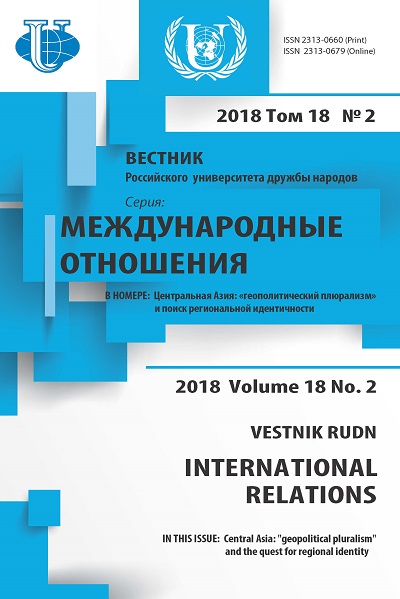MIGRATION FLOWS FROM CENTRAL ASIA TO EUROPEAN UNION COUNTRIES
- Authors: Kurylev K.P.1, Kurbanov R.M.1, Makenova A.B.1, Khotivrishvili A.A.1
-
Affiliations:
- RUDN University (Peoples Friendship University of Russia)
- Issue: Vol 18, No 2 (2018): Central Asia: “geopolitical pluralism” and the quest for regional identity
- Pages: 315-327
- Section: PEACE AND SECURITY
- URL: https://journals.rudn.ru/international-relations/article/view/18883
- DOI: https://doi.org/10.22363/2313-0660-2018-18-2-315-327
Cite item
Full Text
Abstract
The system of international relations is in constant change, where new challenges, problems, trends are emerging. In this context, the global migration is no exception. The central question of this study is that labor migrants from Central Asia are changing their traditional directions, where Russia is replaced by other European countries. Such a trend can not be short-term for a number of reasons, both internal and external. Globalization, which neutralizes the natural borders of states, contributes to the gradual growth of world migration. Moreover, the leading countries of Europe with a high level of economic development have always attracted foreigners who were in search of work and a better life. Among other reasons of this problem is the rapid demographic development of Central Asia, the interest of European countries in cheaper labor, but quite qualified. In addition, the economic crisis in Russia, the complication of migration policy, the weakening of the currency, as well as the dependence of the budget of the Central Asian countries from remittances from abroad, it provokes great interest in changing traditional migratory direction. The objective of the research is to investigate the phenomenon of gradual increase in the number of migrants from Central Asian countries to Europe and analyze causes and consequences of this phenomenon in the context of the current international situation. Summarizing the results of the research, the authors make the important conclusion that the number of migrants from Central Asia in the countries of the European Union is gradually increasing. In the next decades this phenomenon will also be relevant because of the high birth rate and relatively young middle age of citizens in the countries of Central Asia, the EU’s need for cheap and at the same time qualified labor, a low level of the Central Asian economy and the economic crisis in Russia.
About the authors
Konstantin Petrovich Kurylev
RUDN University (Peoples Friendship University of Russia)
Author for correspondence.
Email: kurylev_kp@rudn.university
Doctor of History, Professor of the Department of Theory and History of International Relations of Peoples Friendship University of Russia
Ruslan Magomedovich Kurbanov
RUDN University (Peoples Friendship University of Russia)
Email: kurbanovr25@gmail.com
MA student of the Department of Theory and History of International Relations of Peoples’ Friendship University of Russia
Asiya Bazarovna Makenova
RUDN University (Peoples Friendship University of Russia)
Email: 1032163970@rudn.university
MA student of the Department of Theory and History of International Relations of Peoples’ Friendship University of Russia
Anna Aleksandrovna Khotivrishvili
RUDN University (Peoples Friendship University of Russia)
Email: 1032165394@rudn.university
MA student of the Department of Theory and History of International Relations of Peoples’ Friendship University of Russia
References
- Bolshova, N.N. (2012). Germany’s immigration policy towards highly-skilled workers in the 21st century. Vestnik MGIMO, 6, 226—237. (In Russ.).
- Gusakov, N.P. & Andronova, I.V. (2014). Common Migration Policy as a Part of Common Economic Space: Problems of Figuring out and Perspectives of Implementation. Vestnik RUDN. International Relations, (4), 78—86. (In Russ.).
- Ivanov, I.S. (Ed.) (2013). Interests of Russia in the Central Asia: Content, prospects, constraints, 10. Moscow: The Russian International Affairs Council. (In Russ.).
- Kastkin, P.I. & Khrustalev, I.M. (2012). Integration, European security and soft power of migration. Vestnik MGIMO, 6, 79—93. (In Russ.).
- Mansur, A., Kuillin, B. (2008). Migration and remittances. Eastern Europe and the former Soviet Union. World Bank. Moscow: All the World. (In Russ.).
- Mendikulova, G. (1997). Historical destinies of the Kazakh Diaspora. Astana: Galym. (In Russ.).
- Ryazantsev, S.V. (2016). Labor migration from Central Asia to Russia in the context of the economic crisis. Valday notes № 55. (In Russ.).
- Sitnyansky, G.Yu. & Bushkov, V.I. (2016). Migration of the population in Central Asia: past, present and future. Moscow: Institute of Ethnology and Anthropology, Russian Academy of Sciences. (In Russ.).
- Tsapenko, I.P. & Monusova, G.A. (2017). Integration potential of ethno-cultural diversity in European societies. Polis. Political studies. № 4. P. 90—105. DOI: https://doi.org/10.17976/jpps/ 2017.04.07. (In Russ.).
- Chudinovsky, O.S. (2011). Statistics of international migration. A practical guide for countries of Eastern Europe and Central Asia. Geneva: United Nations Economic Commission for Europe. (In Russ.).
- Timmer, H. (2017). Migration and Mobility in Europe and Central Asia. World Bank Group. International Bank for Reconstruction and Development. URL: http://documents.worldbank.org/ curated/en/445651508415857577/pdf/120539-replacement-PUBLIC.pdf (accessed: 28.12.2017).
- Myhre, M.H. (2012). Labour migration from Central Asia to Russia — State Management of Migration. University of Oslo. URL: https://www.duo.uio.no/bitstream/handle/10852/33968/1/ MasteroppgavexxMyhre.pdf (accessed: 28.12.2017).











